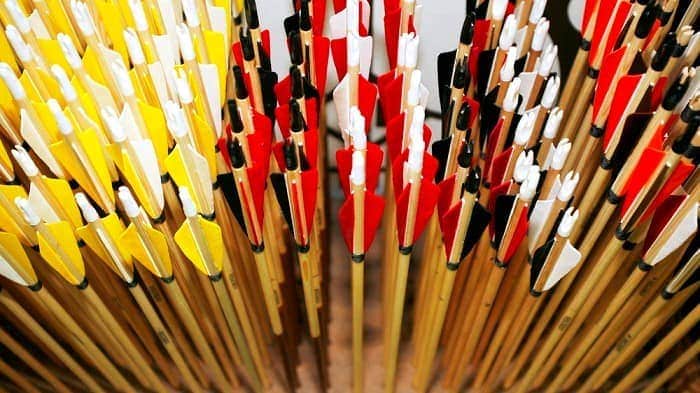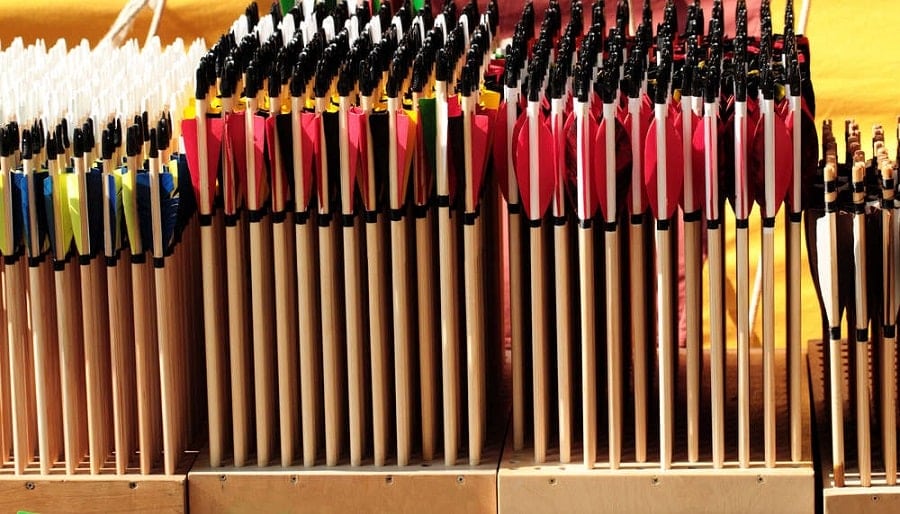How Long Should An Arrow Be For A 29 Draw
Outside of your bow itself, there are few items equally valuable to an archer's overall level of success than their arrows. When arrows are properly selected and prepared, an archer has presented the opportunity to make the almost of their shooting.
One item job associated with preparing your arrows for the range is ensuring that they are all cut to the proper length.
This leaves many archers questioning how to make up one's mind perfect arrow length. Luckily, calculating arrow length requires fiddling more than than simple measurement, and can be determined in a matter of minutes.
We have heard the question "How long should my arrows exist for a 29 inch draw" enough of times.
The correct answer is to cutting them to the length that creates the proper spine for your setup. If you´re a beginner I would recommend a good pro shop where they aid you effigy this out.
Why Is Arrow Length Of import?
Using just those arrows which accept been cut to the proper length is important for several reasons. These reasons vary in nature, encompassing concerns related to both safety and efficiency.
An arrow that is also long poses boosted weight that must exist stabilized mid-flight, and that has the potential to touch on an arrow's trajectory.
Equally a general rule, it is appropriate to get out an arrow no longer than what is needed to provide a safe shooting scenario.
Arrows that have been cut too brusk are an even greater concern, as they tin can get an enormous safety liability.
An arrow that is too short in length has the potential to make contact with a bow'south riser, or an archer'southward hand upon release.
This tin atomic number 82 to injury and/or erratic arrow flight.

How To Measure & Calculate Arrow Length
There are multiple schools of thought on the best possible way to measure for proper pointer length.
While these methods vary slightly from one another, they all accomplish the same goal, which is to provide an archer with an pointer that is prophylactic to shoot.
Standard Depict Length Based Measurement
Many archers cull to measure their arrows before cutoff by adding ane ½" to their draw length, which should provide a ballpark length measurement that positions the arrow's tip slightly past a bow's riser at total describe.
In general, this is an excellent way of measuring arrow length when shooting a recurve bow or whatever other type of traditional bow.
This ensures that enough arrow length remains, that an archer does not put themselves in harm's way, should their bow be slightly overdrawn.
Shaft Marking At Full Draw
Some other alternative way of measuring an pointer for length is to mark its cut off signal when fatigued as if being fired.
This is especially popular with compound archers, as overdraw is oftentimes less of a factor with the presence of a somewhat rigid back wall.
When measuring an arrow with the use of this method, the help of a second individual is required.
The pointer that is to be measured volition be nocked as if it is to be fired, and the bow volition be pulled into the full describe position.
Once at full draw, a helper will mark the pointer shaft at a designated point in relation to the bow'due south riser.
For many archer'southward this betoken of intersection will exist that of where the shaft is even with the forepart edge of the riser itself.
Once a mark has been fabricated, an actual measurement tin can be taken and applied to all other arrows that are to be cutting.
The employ of a safety release is besides highly advisable when taking pointer measurements in this fashion.
The utilise of a safe release prevents the bow from beingness accidentally discharged while beingness held for marking the arrow for length, thereby ensuring the rubber of all involved.
Measurement Arrow Use

Another form of arrow length measurement involves the use of a purpose-built pointer.
These arrows are marked along their shaft in designated intervals down to ¼". An archer just nocks the measurement arrow and comes to total draw.
In one case at full draw, an assistant notates the correct arrow length measurement based upon those provided by the specialty arrow.
This measurement is then applied to all arrows that are to exist cut to length, providing a simple, all the same effective template to guide your efforts.
To meet this technique of measuring an arrow used, watch this video.
How Arrow Measurements Are Defined
When measuring an arrow'southward overall length, any measurement that is taken should cover the altitude from the throat of the nock, to the point where any cut is to be placed at the arrow'south opposing end.
By definition, the throat of a nock is the recessed internal section wherein the bowstring rides when an pointer is placed on the residue.
In one case all arrows have been cutting to length, 1 should carefully inspect each arrow shaft, making sure that all cuts are perfectly square, and no swell or splintering of the shaft material is observed.
It is too of import to double-check that the lengths of all shafts match and that no mistakes have been made during the measuring and cutting process.
Arrow Length Calculation Fabricated Easy
While the thought of measuring and cutting an arrow to length can seem intimidating to some, the process itself is far less troublesome than many would believe. And the best thing is, you don't need a fancy arrow length to draw length chart to be on the safe side!
Just continue in mind that you can always cut additional shaft length off if arrows are institute to exist too long, but you tin can never add together to an arrow's length if it has been cutting also curt.
By taking your time and employing a "mensurate twice cut in one case mentality", you will be rewarded with arrows of the perfect length that will offer a safety, enjoyable shooting experience well into the future.
Parts of an Arrow

Even before the ideal length of an arrow tin be adamant, one must familiarize themselves with the overall anatomy of an arrow, and be capable of understanding varying terminology associated with its parts.
The following is a breakup of an arrow's individual components and segments.
Nock:
An arrow'southward nock is found at its rearmost indicate, opposite that of the arrow tip. This component allows an pointer to exist fitted to an archer's bowstring in grooming for an upcoming shot.
Most modern carbon or aluminum arrows characteristic nocks made of plastic, that are hands replaceable if damaged.
Fletchings:
Fletchings are thin, angled pieces of material that protrude outward from their attachment point with the arrow's shaft at a 90-degree angle.
The purpose of fletchings is to stabilize an arrow'southward flight. Fletchings come in two main varieties, feathers and vanes.
- Feathers – Plume-style fletchings offer maximum arrow stability when in flight and resist any possible deflection upon the arrow's release. On the downside, plume fletchings are not waterproof and can be adversely affected by moisture weather.
- Vanes – Vanes-style fletchings typically consist of a thin plastic construction, and are extremely resistant to the elements.
Fletchings can influence arrow flight slightly, in the issue of coming into contact with whatever component upon the arrow's release.
However, the advent of mod drop-away arrow rests has largely eliminated problems of this nature, in their entirety.
Shaft:
The long cylindrical segment of the arrow's body, to which every other component attaches, is known as the shaft.
When cutting an pointer to length, the shaft is where the departing cut volition accept place.
The iii most common arrow shaft materials are carbon, aluminum, and wood.
- Carbon– Carbon is the most popular of all arrow shaft materials, as it is highly resistant to deformation and extremely durable. Notwithstanding, carbon arrow shafts can brainstorm to develop minor cracks within their cobweb limerick in fourth dimension and should exist regularly inspected for any defects.
Carbon arrows are besides somewhat pricey in relation to alternative pointer shaft materials, such as aluminum.
- Aluminum – Aluminum arrow shafts were quite pop for several years, though their popularity began to wane with the popularization of carbon arrows. Aluminum arrow shafts offer the same notable accuracy and consistency every bit carbon arrows, though at a more than economical toll point.
However, aluminum arrows are prone to deformation when hitting solid objects, and do not return to their original form once aptitude.
- Woods– The apply of wooden arrows dates dorsum nearly equally far as recorded history itself. These arrows are suitable for use with any type of bow, though their primary employ in the modern era is about exclusively by traditional archers. Wooden arrows are more than decumbent to distortion and breakage than the other above-mentioned shaft materials.
Inserts:
The majority of today's arrows utilize inserts that are affixed at the finish opposite the arrow'southward nock.
These inserts are glued into the hollow end of an arrow shaft and characteristic internal threads.
With an insert in identify, an archer'due south caput of option tin exist threaded into identify every bit desired.
Bespeak/Head:
Attached to the business organisation end of an arrow is a point or head. The verbal type of bespeak or head that is to be used is ultimately dictated by the type of shooting that is to accept identify, with many such heads available for buy.
Feel free to go out any comments or questions that you might have, as we appreciate any feedback from our readers.
FAQ:
Why Is Arrow Length Of import?
Using only those arrows which have been cut to the proper length is important for several reasons. These reasons vary in nature, encompassing concerns related to both safety and efficiency.
An arrow that is too long poses additional weight that must exist stabilized mid-flight, and that has the potential to touch an arrow'southward trajectory.
How Long Should An Arrow Be For A 29 Draw,
Source: https://bowaddicted.com/how-to-determine-the-perfect-arrow-length/
Posted by: whartonteme1960.blogspot.com


0 Response to "How Long Should An Arrow Be For A 29 Draw"
Post a Comment